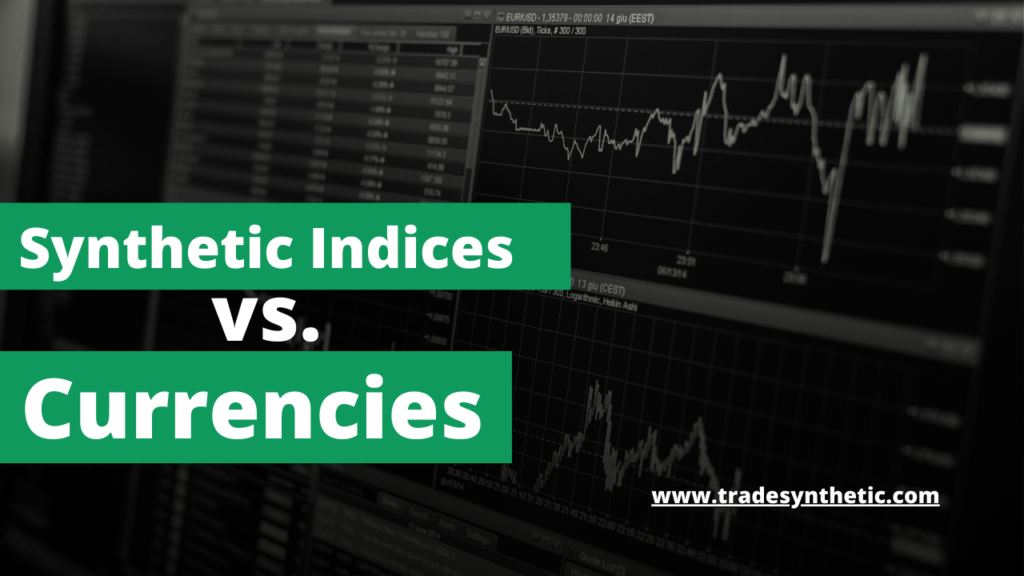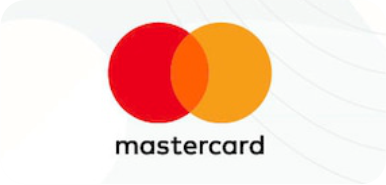Synthetic indices vs currencies (Forex Trading) are Among the tens of thousands of instruments Trader’s use. This article explores the key differences, pros, and cons of trading synthetic indices versus traditional currencies.
What Are Synthetic Indices and Currencies?
Synthetic Indices
Synthetic indices are market instruments designed to mimic real-world market movements without being influenced by economic or geopolitical factors. They are created using algorithms and are often offered by specific brokers like Deriv. These indices include instruments like Volatility Indices, Boom and Crash Indices, and Step Indices.
Currencies (Forex Trading)
Currencies, or forex (foreign exchange), involve trading currency pairs like EUR/USD, GBP/JPY, or USD/CAD. Forex prices are influenced by economic events, interest rates, political decisions, and market sentiment.
Both synthetic indices and currencies have distinct characteristics, and understanding their pros and cons helps traders make informed decisions.
Differences Between Synthetic Indices and Currencies
- Market Influence
- Synthetic Indices: Not affected by real-world events; rely solely on algorithmic calculations.
- Currencies: Prices depend on factors like GDP growth, employment data, geopolitical tension, and central bank decisions.
- Market Hours
- Synthetic Indices: Available 24/7, including weekends.
- Currencies: Operate 24/5 during the week, with trading closed on weekends.
- Volatility
- Synthetic Indices: Offer fixed or predictable volatility levels.
- Currencies: Volatility fluctuates based on market events.
- Accessibility
- Synthetic Indices: Limited to brokers like Deriv.
- Currencies: Accessible through numerous global brokers.
Similarities Between Synthetic Indices and Currencies
- Speculative Trading Opportunities: Both synthetic indices and currencies offer traders opportunities to speculate on price movements. In both markets, traders can go long (buy) or short (sell), aiming to profit from price fluctuations.
- Technical Analysis: Whether trading synthetic indices or currencies, traders often rely on technical analysis to make decisions. Both markets provide chart patterns, support and resistance levels, candlestick patterns, and other technical tools to guide trading strategies.
- Leverage: Both synthetic indices and currencies often offer leverage, allowing traders to control larger positions with a smaller amount of capital. This increases the potential for both profits and losses.
- Risk Management: In both markets, managing risk is essential. Traders in both synthetic indices and currency markets use stop-loss orders, take-profit levels, and position sizing to manage exposure and limit potential losses.
- Short-term and Long-term Trading: Both synthetic indices and currencies can be traded on various timeframes. Whether a trader prefers short-term trading, such as scalping or day trading, or longer-term trading, such as swing or position trading, both markets offer opportunities for a wide range of trading styles.
- Market Liquidity: Both synthetic indices and currencies offer good liquidity, particularly with major currency pairs and popular synthetic indices like the Volatility indices. Liquidity ensures that traders can execute trades efficiently without large price slippage.
- Price Movements: Both synthetic indices and currencies can experience significant price movements in short periods, providing traders with opportunities for high returns, especially during periods of increased volatility or trend development.
- Broker Support: Trading in both synthetic indices and currencies typically requires a broker, with many brokers offering platforms that allow access to both markets. These brokers may provide educational resources, trading tools, and customer support to assist traders.
- Risk of Losses: In both synthetic indices and currency markets, traders are exposed to risk. While synthetic indices may be based on algorithms and currency markets on global economic factors, both markets carry the potential for significant financial losses.
Pros and Cons of Synthetic Indices and Forex Trading
| Pros of Synthetic Indices | Cons of Synthetic Indices |
| 24/7 Availability – Trade anytime, including weekends. | Limited Broker Options – Mainly offered by brokers like Deriv. |
| No Market Influences – Not affected by news, geopolitical factors. | Potential Addiction Risk – The continuous nature of trading can lead to overtrading. |
| Predictable Volatility – You can choose indices with fixed volatility levels. | Unregulated Environment – Some regions lack oversight for synthetic indices, posing potential risks. |
| Transparency – Algorithms ensure transparency and fairness. | Fixed Payouts – Some indices have capped returns, limiting profit potential. |
| Unique Instruments – Options like Boom and Crash cater to unique trading strategies. | Lower Liquidity – Compared to forex, synthetic indices have lower trading volumes. |
| Pros of Forex Trading | Cons of Forex Trading |
| High Liquidity – Forex is the largest market in the world, ensuring tight spreads. | Market Volatility – Prices are affected by news events, making them unpredictable. |
| Diverse Opportunities – Numerous currency pairs offer various trading options. | Weekend Gaps – Markets close on weekends, and price gaps can occur when trading resumes. |
| Leverage – Many brokers offer high leverage, enabling larger positions with less capital. | Dependency on News – Staying informed about global events is essential and time-consuming. |
| Wide Broker Availability – A range of brokers offer forex trading platforms. | Broker Risks – The presence of unregulated brokers can pose a risk to traders. |
| Economic Correlation – Forex markets are influenced by economic indicators, providing opportunities for fundamental analysis. | Complex Analysis – Requires understanding of global economic factors and market sentiment. |
Choosing Between Synthetic Indices and Currencies
- Risk Appetite
- Choose synthetic indices if you prefer a predictable environment and can manage 24/7 trading.
- Opt for currencies if you can handle market unpredictability and want diverse opportunities.
- Trading Style
- Synthetic indices are suitable for scalpers and intraday traders due to their fixed conditions.
- Currencies cater to swing traders and long-term investors who focus on macroeconomic trends.
- Experience Level
- Beginners might find synthetic indices less overwhelming due to their simpler structure.
- Advanced traders might gravitate toward currencies for their complex, dynamic nature.
Conclusion
The choice between synthetic indices and currencies depends on your trading style and goals. Synthetic indices offer 24/7 availability and predictable movements, while currencies provide liquidity and real-world economic opportunities. Understanding their differences and applying proper risk management is key to success. Choose the market that aligns with your strengths and trading preferences.
Frequently Asked Questions (FAQs)
What is the difference between synthetic indices and currencies?
- Synthetic indices are algorithm-based instruments unaffected by real-world events, while currency prices depend on economic and political factors.
Can I trade synthetic indices on weekends?
Yes, synthetic indices operate 24/7, making them available on weekends.
Are synthetic indices better than forex?
- It depends on your trading style. Synthetic indices offer a predictable environment, while forex provides diverse opportunities based on global events.
Which is riskier: synthetic indices or currencies?
- Both have inherent risks. Synthetic indices have fixed volatility, while currencies can experience unpredictable price swings due to news events.
Where can I trade synthetic indices?
- Synthetic indices are available on platforms like Deriv, which specialize in these instruments.
Do currencies offer better profits than synthetic indices?
- Profitability depends on your strategy, risk management, and market conditions rather than the instrument itself.
Which trading platform is best for synthetic indices?
- Deriv’s proprietary platform is the most popular choice for synthetic index trading.
Can I trade both synthetic indices and currencies simultaneously?
- Yes, many traders diversify their portfolios by trading both instruments to balance risk and capitalize on different market opportunities.










